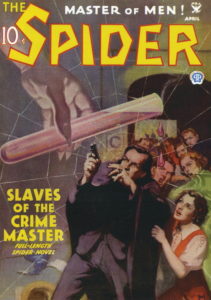
“Slaves of the Crime Master “was originally published in the April 1935 issue of The Spider Magazine. A magically persuasive radio voice lures thousands of young people to crime; a scientific madman deals germicidal death over the nation’s children. Can even The Spider find a way to free humanity from the grip of wholesale destruction being planned for it by the greatest of all Crime Masters?
Here’s a Spider story that really let me down. A great build-up that leads to a confusing and disappointing conclusion. There’s much left unanswered. I’m not talking about minor details, here… I’m talking about major plot points. And the grand finale is so muddled that I’m still not sure who died or who the bad guy was. Yes, I read it a second time. Actually, I think I read it five times, trying to make sense of it. Did author Norvell Page accidentally use the wrong character’s name? If so, I couldn’t figure out who, and in what place. Didn’t the editors even read this thing? Any semi-competent person who reads it will realize the ending makes no sense. And the sad thing is that the previous 95 percent of the story was very good. That made me feel all the more cheated.
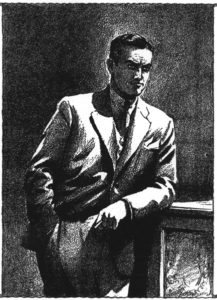
Double threat
There are two major threats in this story, both perpetrated by the same criminal gang and their unknown, sinister leader. A voice comes over the radio. It’s a magnetic voice backed by haunting music, and it charms young people into leaving their homes and turning to crime. This man, known as the Tempter, turns the nation’s teens into a rampaging mob of criminals. Law enforcement is baffled in their attempts to trace the broadcasting signal. It seems to come from outer space! That’s one threat.
The second threat to the safety of our country is infantile paralysis, more commonly known today as polio. There is a sudden outbreak of the illness across the land, and the man behind it plans on selling the antitoxin for a hundred thousand dollars a shot. Desperate parents will pay!
The thing that really hinders The Spider in his battle against crime is that although he has no qualms about killing criminals, often shooting them between the eyes, he can’t bring himself to kill a child. So when children turn to crime, The Spider has no way to fight back against them. Mobs of teens run amok and The Spider must stand by helplessly, begging them to stop. Yeah, that conscience thing really puts a crimp in his battles against the forces of evil.
As is typical in most Spider stories, the police act in such an irresponsible and caviler fashion that it strains credibility. A group of a hundred youngsters gather in an old saloon, listening to the Tempter on the radio. The Spider shows up and pleads with the kids to go home. Police show up, and when they realize The Spider is inside, they open up with their guns. The Spider yells for the police to hold their fire; there are more than a hundred children in the building. But the police, apparently angered at the past humiliations they have received from The Spider, ignore him. Guns deluge the windows with lead. That’s right, put innocent children at risk…
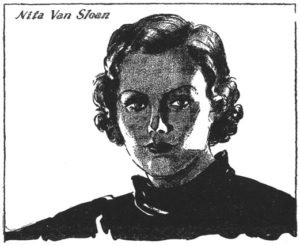
Over the police radios come the words “Stop The Spider! Shoot first! Shoot to kill!” But why? The story has just started, and there is no reason given for such drastic action. As has been seen time and time again, the police are instructed to shoot to kill without provocation or justification… they just do it. All this plays into the rampant paranoia that is a constant theme in The Spider stories.
Early on in the story we are told that Police Commissioner “Kirkpatrick came to understand that The Spider operated always on the side of law and order.” So, then, why the kill order? No, it doesn’t make sense, but in the unique universe inhabited by The Spider, it never does.
Five suspects
Police Commissioner Stanley Kirkpatrick has five suspects who may be the Tempter. He summons all five to his office where their voices will be compared to a recording made of the man on the radio. But nothing seems to come of it. The results are inconclusive, and the attempt at matching the voice is abandoned after four of the five have been tested. This is also typical of The Spider stories. Things pop up that sound promising, but then are left unresolved. It’s almost as if the editors needed space filler, and used this to add a couple pages. They could have left out that entire scene, and it wouldn’t have mattered.
But it does serve to introduce us to the five suspects. Wentworth figures the Tempter is someone who earns a living with his voice, so he has selected politicians, radio and theatrical stars, lecturers and preachers. Eugene MacThune is a popular radio announcer. Basil Cathcart, stage actor, is next. Charles Ray Gibbony, state senator. Yogi Swami Rich preaches the “one true way” to wealthy ladies. Father Burkan of the new Conventionists Church is a radio preacher with a million listeners. Unfortunately, the climax of the whole story is so muddled that we never really learn which one is the Tempter.
So when it comes down to the nitty gritty, what’s it all about? Well, we finally find out that there are two bad guys, here. The chief baddie is a scar-faced Doctor who loves to torture others, and who is responsible for the infantile paralysis epidemic. His flunky does the radio work and is known as the Tempter. The reason for inciting the children to crime is to collect dues from the kids. One boy lets it slip, and later is murdered by his friends. And the polio is being spread by a newly invented “transparent, moisture-proof wrapper.” Sounds like today’s common plastic wrap, to me.

By story’s end, things have gotten pretty grim. Overnight a thousand children die from infantile paralysis and thousands more will be deformed for life. In Chicago, 50 youngsters get ahold of guns and are murdering wantonly. Police are ordered to shoot them down. Humanitarians object, but nothing can stay the rapid moral disintegration of the young. The city was in turmoil. Radio sets were confiscated, but broadcasts continued to reach the ears of children. Somehow.
But as the story winds down, things start to fall apart, plot-wise. Nita has been kidnapped and is freed by The Spider. She finds she has been taken to Vermont, and must drive back to Manhattan to warn Kirkpatrick that the Doctor plans on infecting the crowd at a baseball game. It’s a six-hour drive and she must race back there in time. And so she does, breaking speed laws all the way. What? Hasn’t she heard of a telephone? One simple phone call could have eliminated that frantic drive back.
Strike three!
At the ball game, the plot gets really messed up. Wentworth lowers a giant fake spider from the roof of the ball park, and drops a dead man made up to look like the Doctor. The Tempter is in the stands, and mistakes the dead body for his boss. The real Doctor is alive and shoots the Tempter because he blurts out his true identity. But then The Spider kills the Doctor with his poison web (more about that, later), and he’s revealed to be the same man the Doctor just shot. No, it doesn’t make sense. I tried… I really tried to figure it out, even to substituting other names, in case there was an inadvertent typo somewhere. I finally gave up. I guess the important thing is that both bad guys are dead at the end, even through I couldn’t figure out who they were.
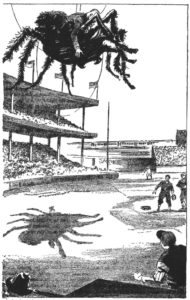
The final details are wrapped up quickly and also make no sense. Wentworth claims he got away from the gang that had him surrounded (remember, when he released Nita) by working on a bomb using his explosive. Huh? What explosive? There was no explosive in the story. This just comes out of left field.
He explains away the radio broadcasts, which couldn’t be traced, in a single sentence. He found a beam radio which sent its signals straight upward and bounced them off the stratosphere. And that is supposed to explain how authorities couldn’t trace those broadcasts from the Tempter.
And how did the Tempter take over the minds of children and make them revolt? It’s never explained… not even referenced. Now that’s just inexcusable. The least that Novell Page could have done is thrown out some one-sentence scientific gobblety-gook explaining that, for example, “the broadcasting set was fitted with an oscillator that resonated at a frequency sensitive to young minds.” See, even I could come up with some phony explanation. Why couldn’t have Page?
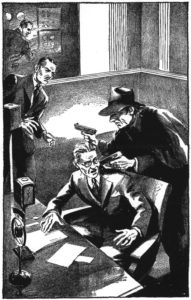
Not all bad
I will admit there are some pretty cool scenes in this story. I really liked it when The Spider broke into the radio broadcasting building and took over a broadcasting studio to make his own appeal to radio audiences.
In one place, The Spider is surrounded by a gang of 200 youths. He won’t harm children, so he’s taken captive. A 12-year-old tries to stab him. An 11-year-old is coached to shoot him. Man, what’s a guy gonna do?
The Spider challenges some of the city’s biggest racketeers, in some vague attempt to put a crimp in the master criminal’s activities. This is ambiguous, as it’s never spelled out how these racketeers are related to the mastermind. They don’t seem to work for him or have any connection. But nonetheless, The Spider goes out of his way to kill each of them in very unique ways, which are pretty cool. The Spider throws a poisoned net over each man. Needles of dry ice, impregnated with curare are fastened all over the web. A single puncture of the skin is enough to kill. Those who touch the net fall quivering to the floor and are dead in under 20 minutes.
Over a period of five days, The Spider kills five gangsters in this manner. Since this really has nothing to do with the youth revolt or the infantile paralysis, it appears to me to be filler material. The editors could easily cut one or two of the gangsters’ deaths for space, if needed. Or add another death to take up more space. Yes, it sure looks like filler to me. But I’ve got to admit that it is exciting filler.
It gets gruesome when we visit the Doctor’s headquarters, where children are used as laboratory animals to make infantile paralysis antitoxin. The body of one child supplies enough for a thousand inoculations, which will sell for $100,000 per shot.
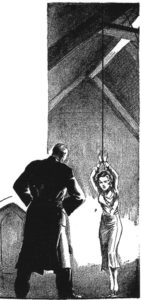
And wait for the torture scene with Nita and another young woman. This is about as gruesome as I’ve seen in a pulp magazine story. She is not tortured for information. She is tortured simply because the Doctor likes it. The young woman has her hands tied behind her. She is lifted by a rope ties to her hands, her entire weight upon the arms behind her back. Lifted and dropped, then the rope pulled tautly, yanking the arms upward. After several times, she is raised over 20 feet, dropped about 10, and suddenly jerked to a halt. Her arms are ripped from her body, which falls the last 10 feet to a bloody mess on the floor, the arms left dangling from the rope above. Yeck! And now Nita is slated for the same…
Send away for your Spider ring!
This story goes out of its way to promote The Spider League and The Spider ring. Both were promotional items that the pulp magazines were pushing. The special ring had been available for a year, first promoted in “The Citadel of Hell” in March 1934. The boys and girls club apparently was something more recent. The story has a young protagonist George Hart who helps The Spider. He also forms a Spider club for young folks to fight the evils of the Tempter.
In one climactic scene, two separate gangs of youths battle each other. One is a criminal gang, under the influence of the Tempter. The other is a gang headed by young George Hart. He refers to his club members as Spiders. They wear the club insignia on their fingers, The Spider ring!
Wow, this is enough to make any boy or girl want to go out and join their own local Spider club and get their own Spider ring. Hey, wait a minute! What are kids doing reading this stuff. It’s way too gory for them. Parents, are you letting your youngsters read Spider pulp magazines? Shame!
The original title of this story, as submitted to the publishers, was “Hell’s Revolt.” But they changed it to “Slaves of the Crime Master,” and I suspect in the process did some editing, as well.
Thumbs down
Perhaps the editors should have taken a little more care with this story. Often editors got lazy as the series ran on into its later years, but this story was fairly early in the magazine’s run. There’s really no excuse for the sloppy ending of this Spider story. It had a lot going for it up until the confused mess that was the end. And so, in the end, it let me down. A clinker.

